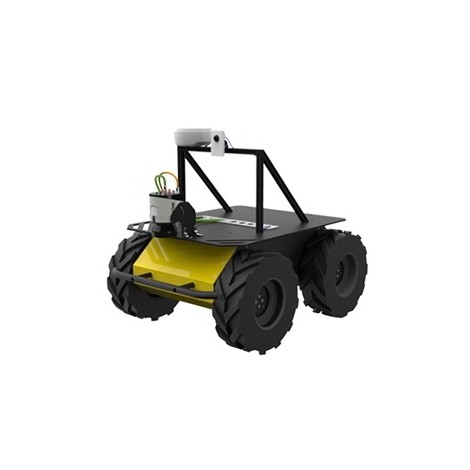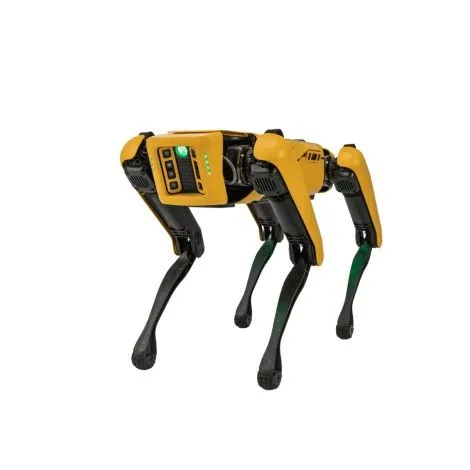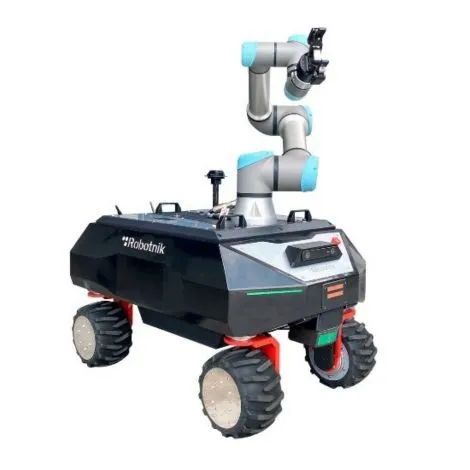Mobile robots
Mobile robotics can be a real game changer in many projects. Mobile robots are powerful tools, which autonomy can take over from humans strenuous or dangerous tasks.
What is an autonomous mobile robot?
An autonomous mobile robot is a robot that can move around in an open or closed space. It does not remain stationary in one position. The autonomous mobile robot can map its environment and navigate on its own, without being controlled by an operator.
Autonomous mobile robots do not need any external relays to operate (such as beacons). Instead, they use SLAM (Simultaneous Localization And Mapping) technology, which enables them to build a map of their environment in real time, and do some self-localization. If needed, autonomous mobile robots can also be remotely operated.
Usually, an autonomous mobile robot is made up of:
- A chassis (with motors and controller)
- An embedded computer
- A battery
- Sensors (at least a LiDAR)
- Actuators
The sensors and actuators will change depending on the tasks the robot has to perform.
Types of sensors:
- Thermal sensor
- Panoramic camera
- Gas sensor
- Motion sensor
- Microphone
- Etc
Type of actuators:
- Robotic arm
- Screen
- Speakers
- Drone
- Etc
Mobile robots: missions and applications
In which situations can mobile robotics be a real advantage? We won't list the many tasks a robot can take over from humans, there are too many. We will list the one we are familiar with at Génération Robots. For example, for inspection tasks in hazardous environments, mobile robots are essential for ensuring safety and efficiency.
Missions where a robot can be essential, or mandatory:
- Nuclear dismantling
- Space exploration (rovers, sample collection, etc)
- Heavy equipment transport (construction sites, rescue missions, scientific missions, etc.)
- Transport of mail, medication, light equipment, within a single building, a complex or a district
- Robotised cowshed cleaning
- Surveillance and preventive maintenance of sensitive sites (SEVESO sites, airports, oil & gas)
- Etc
How to choose the right mobile robot for your project?
The environment and the terrain are both major considerations, as they cannot be easily changed.
Depending on the environment and the terrain on which the robot will drive, as well as its missions, the locomotion will be different:
- Mecanum wheels ➡ allows lateral movements, suitable for warehouses and indoor navigation (Clearpath Robotics' Dingo robot type)
- All-terrain wheels ➡ for outdoor navigation, suitable for exploration missions, agriculture, etc (RR100 robot type from Generation Robots)
- Tracked ➡ outdoor navigation, on uneven terrain (potholes, small ditches, rocks, steps, etc) (Bunker Pro robot type)
- 4 legs ➡ allows robots to move on stairs or rocks (Spot robot type). Some hybrid models, such as the B2 from Unitree Robotics, have wheels at the end of their legs.
You will also need to consider the following features:
- The payload (does the robot need to carry heavy equipment?)
- Autonomy (an important factor in surveillance and security missions)
- Agility (speed and turning radius)
- The budget allocated to the project
Other factors, such as the possibility to quickly add extra addons, can also be important. Agilex mobile robots are equipped with rails that allow for quick customization.
Finally, ROS/ROS 2 compatibility is often a major factor in the choice of a mobile base, especially for research and R&D centers. All our mobile robots are ROS compatible.
In this construction kit, the small Leo Rover mobile robot bares all, from A to Z. The Leo Rover Developer Kit allows you to assemble the robot’s essential components. With internal Raspberry Pi, powerful controller and ROS-based software you’re ready to begin programming!
UNITREE Robotics recently unveiled its latest masterpiece (end of 2023): the B2, an industrial quadruped robot capable of achieving a remarkable speed of 6 m/s (21,6 km/h).
The Cobot S provides a comprehensive solution for mobile collaborative robots, incorporating high-performance industrial computers, a LiDAR, an IMU, a multi-DOF robotic arm, as well as visual perception.
A high-performance autonomous Cobot Kit designed for educational research in robotics and industrial development.
The Spot Inspection package provides reliable real-time data to automate all your inspection missions.
The TurtleBot 4's mobile robot is built on top of the iRobot® Create® 3 educational robot that provides an IMU, optical ground tracking sensor, and wheel encoders for precise positioning and location. TB4 comes in two models: TurtleBot 4 Standard and TurtleBot 4 Lite
The agile, perceptive and highly observant SMART robot is an intelligent mobile platform and an expert in navigating hostile environments. It avoids all obstacles while mapping its environment in real time.

This 100% ROS four-wheel drive mobile base is an outdoor pro. Use this durable Rover to carry heavy loads on any terrain.
Both robust and compact, the Boxer Mobile Robot is an indoor platform designed for developing robotic solutions and technologies. 100% ROS, it offers a wide range of possibilities for researchers and designers.
The Leo Rover is a mobile research and educational robot running on a Raspberry Pi 3 that you can customise at will thanks to a wide range of modules!
UNITREE Robotics recently unveiled its latest masterpiece (end of 2023): the B2, an industrial quadruped robot capable of achieving a remarkable speed of 6 m/s (21,6 km/h).
The LIMO COBOT is a composition of the LIMO PRO, a ROS development and learning platform, equipped with a Mycobot 280 robotic arm.
Discover the Spot Academia & Innovation kit, a flexible platform for research, teaching, and the development of new applications.
The TurtleBot 4's mobile robot is built on top of the iRobot® Create® 3 educational robot that provides an IMU, optical ground tracking sensor, and wheel encoders for precise positioning and location.
The TEC800 mobile robot is a tracked, remote-controlled UGV unit. It’s a powerful and customisable platform, ideal for research and R&D centres wanting to work on robotics applications.
The SWD® Starter Kit is a development kit for AGVs (automated guided vehicles), AGCs (automated guided carts) and AMRs (autonomous mobile robots). You can use it to rapidly begin developing your own mobile robot compatible with the ez-Wheel SWD® Safety Wheel Drive technology.

This Dingo robotic platform was designed by Clearpath for indoor education and research applications. It comes in two versions: differential drive or omnidirectional drive.
The Scout Mini autonomous mobile base is fast, agile, compact and ROS-compatible. It opens the way for AgileX platforms, a new generation of high-performance UGVs. A robot that can be adapted to many missions as long as you roll up your hacker sleeves. This mobile robot is CE certified.

Make sure you have an extra Leo Rover battery in case you need a back-up power supply for your mobile robot!
Prepare a docking station for your Leo Rover to meet all your land robot's needs!
Discover the ROSbot XL Mobile Robot by Husarion, an autonomous mobile robotic platform designed for Research and Development, rapid prototyping, and creating custom robots for a variety of indoor applications.
Spot Public Safety protects individuals and assess dangerous situations, all while ensuring safety.
Available in 4 versions, the Go2 Edu Plus robot is an ideal tool for Research, Education, and Robotics. It integrates Artificial Intelligence and a 4D LiDAR with hemispheric vision.
The Diablo robot is an innovative robot with 3 different movement modes, which can be used for Research and Development as well as a variety of commercial applications.
































































































